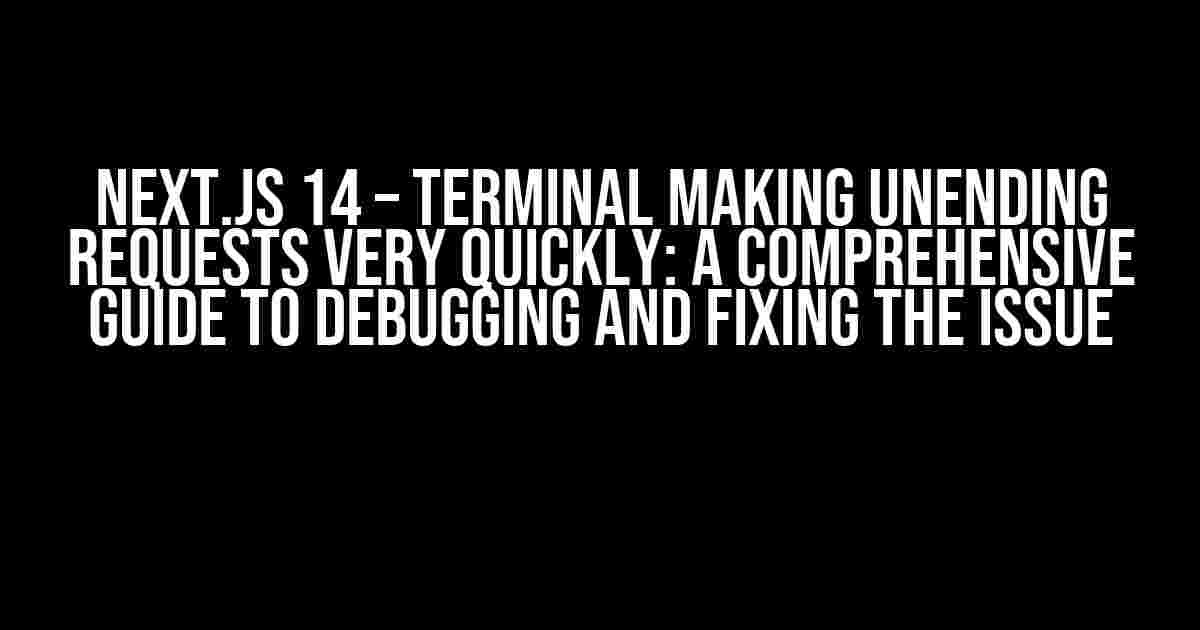Are you experiencing a peculiar issue with your Next.js 14 project where your terminal is making unending requests very quickly? If so, you’re not alone! This phenomenon can be perplexing and frustrating, especially when you’re in the middle of developing a critical feature or fixing a bug. Fear not, dear developer, for we’ve got you covered. In this in-depth guide, we’ll delve into the possible reasons behind this anomaly, and more importantly, provide you with a step-by-step process to identify and resolve the issue.
Understanding the Issue
To better comprehend the problem, let’s break it down into smaller components. When you run your Next.js 14 project using the command `npm run dev` or `yarn dev`, the terminal should display a typical development server output, including the compilation process, page reloads, and any error messages. However, in this scenario, the terminal starts making an unending number of requests very quickly, often resulting in a frozen or crashed terminal.
Possible Causes
Before we dive into the Solutions, it’s essential to understand the underlying causes of this issue. Here are some possible reasons why your terminal might be making unending requests:
getStaticPropsorgetServerSidePropsis causing an infinite loop- Misconfigured
revalidateoption ingetStaticProps - Incorrect implementation of
useEffectoruseLayoutEffecthooks - Recursive function calls or infinite recursion
- Dependency issues or version conflicts with other libraries
- Improper caching or cache invalidation
- Incorrect configuration of the development server
Debugging Techniques
To diagnose the root cause of the issue, you’ll need to employ some debugging techniques. Here are some steps to help you identify the problem:
Enable Debug Logs
First, enable debug logs in your Next.js 14 project by setting the NEXT_DEBUG environment variable. You can do this by adding the following line to your .env file:
NEXT_DEBUG=true
Restart your development server, and observe the debug logs in your terminal. This will provide you with more detailed information about the requests being made.
Next, analyze the network requests being made using the browser’s DevTools or a third-party tool like Chrome DevTools or Fiddler. This will help you identify the specific requests that are causing the issue.
The Next.js Debugger is a powerful tool that allows you to debug your application in a more efficient way. You can activate the debugger by running the following command:
npx next debug
This will start the debugger, and you can then use the Chrome DevTools to inspect and debug your application.
Solutions
Now that you’ve identified the possible causes and employed debugging techniques, it’s time to fix the issue. Here are some solutions to the problems mentioned earlier:
Fixing Infinite Loops in getStaticProps or getServerSideProps
If you suspect that an infinite loop is occurring in getStaticProps or getServerSideProps, review your code and ensure that you’re not making recursive function calls. Instead, use a iterative approach or refactor your code to avoid infinite loops.
Correcting Misconfigured revalidate Option
If you’re using the revalidate option in getStaticProps, ensure that it’s correctly configured. The revalidate option specifies the time in seconds after which the page will be revalidated. A misconfigured value can lead to rapid requests.
export async function getStaticProps(ctx) {
// ...
revalidate: 60, // revalidate after 1 minute
}
Optimizing useEffect and useLayoutEffect Hooks
Review your implementation of useEffect and useLayoutEffect hooks, and ensure that they’re not causing infinite re-renders. Use the `useEffect` hook with caution, and always include a dependency array to avoid unnecessary re-renders.
import { useState, useEffect } from 'react';
function MyComponent() {
const [count, setCount] = useState(0);
useEffect(() => {
// Use a dependency array to avoid infinite re-renders
setCount(count + 1);
}, [count]);
return (
Count: {count}
);
}
Resolving Recursive Function Calls
Identify and refactor any recursive function calls that might be causing the issue. Instead, use an iterative approach or implement a recursive function with a clear termination condition.
function recursiveFunction(n) {
if (n <= 0) return; // Termination condition
recursiveFunction(n - 1); // Recursive call
}
Managing Dependencies and Version Conflicts
Verify that all dependencies are up-to-date and compatible with each other. Use a tool like yarn or npm to manage your dependencies, and ensure that you’re using the correct versions of each library.
yarn upgrade
or
npm update
Configuring the Development Server
Finally, review your development server configuration to ensure that it’s correctly set up. Check the next.config.js file and verify that the development server is not configured to make excessive requests.
module.exports = {
// ...
dev: {
// ...
},
};
Conclusion
In conclusion, the Next.js 14 terminal making unending requests very quickly can be a frustrating issue, but it’s often caused by a simple mistake or misconfiguration. By following the debugging techniques and solutions outlined in this guide, you should be able to identify and resolve the issue. Remember to stay calm, patient, and methodical in your approach, and don’t hesitate to seek help if you’re stuck.
Happy debugging!
| Cause | Solution |
|---|---|
Infinite loop in getStaticProps or getServerSideProps |
Review code, refactor to avoid infinite loops |
Misconfigured revalidate option |
Correctly configure revalidate option |
Incorrect implementation of useEffect or useLayoutEffect hooks |
Optimize hook implementation, use dependency arrays |
| Recursive function calls or infinite recursion | Refactor recursive functions, use iterative approach |
| Dependency issues or version conflicts | Manage dependencies, ensure correct versions |
| Improper caching or cache invalidation | Review caching implementation, ensure correct cache invalidation |
| Incorrect configuration of the development server | Review development server configuration, ensure correct setup |
Remember, debugging is an essential part of the development process. By following this guide, you’ll not only resolve the issue but also improve your debugging skills and become a better developer.
Additional Resources
For further reading and exploration, we recommend the following resources:
- Next.js 14 Documentation: Static Generation
- React Hooks: useEffect
- Debugging with the Browser Console Frequently Asked Question
Having trouble with Next.js 14 and Terminal making unending requests very quickly? Worry not, we’ve got you covered! Here are some frequently asked questions to help you troubleshoot the issue:
What is causing the Terminal to make unending requests?
This issue is often caused by a misconfigured `getStaticProps` or `getServerSideProps` method in your Next.js pages. Make sure to check your page components for any infinite loops or recursive function calls that might be triggering the requests.
How can I debug the issue?
Enable debug logging in your Next.js app by setting the `debug` option to `true` in your `next.config.js` file. This will provide more detailed logs to help you identify the source of the requests. You can also use the Chrome DevTools or a similar browser debugging tool to inspect the network requests.
What if I’m using a third-party library that’s causing the issue?
Try to isolate the library that’s causing the issue by commenting out its imports and functionality in your code. If the requests stop, then you’ve found the culprit! Check the library’s documentation or issue tracker for any similar reports or potential workarounds.
Can I disable the requests temporarily to prevent my server from crashing?
Yes, you can temporarily disable the requests by setting the `target` option to `serverless` in your `next.config.js` file. This will prevent Next.js from making requests to your server. However, be aware that this is only a temporary solution, and you should investigate and fix the root cause of the issue as soon as possible.
Are there any known workarounds or fixes for this issue in Next.js 14?
Yes, the Next.js team has released a patch for this issue in version 14.0.2. Make sure to update your `next` dependency to the latest version to get the fix. If you’re still experiencing issues, you can also try applying the workarounds mentioned in the official Next.js GitHub issue tracker.




